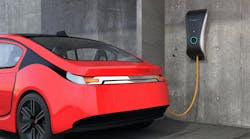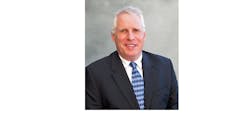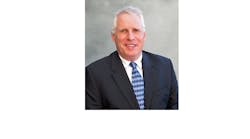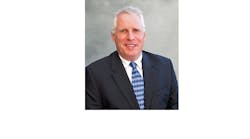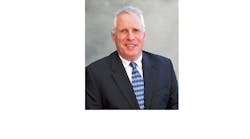Here are EW's picks for the trends that changed the electrical wholesaling industry most over the past decade. Part 2 of two parts.
6. A still-evolving assortment of integrated-supply and national-account contracts comes into play.
It wasn't all that long ago that just a handful of electrical distributors in the electrical wholesaling industry were involved in integrated supply, where they and other distributors from a broad array of industrial and commercial supply disciplines worked together to provide industrial customers with one-stop shopping for dozens of different products. The concept is similar to what once was called "sole source," "single source," "blanket orders" or "national contracts," except that those contracts just dealt with electrical supplies. Many of today's integrated supply deals focus on supplying a larger portion of a customer's integrated supply needs.
Because customer needs on integrated supply contracts differ so much, there's a saying that, "If you've seen one integrated-supply contract, you've seen one integrated-supply contract." The same could be said for the companies and consortiums that pitch these contracts: No two are alike. Here's a rundown of the various takes on integrated supply operating in the distribution business:
A-D Edge. A-D uses a customized software package as the foundation for the integrated supply arrangements that its electrical, industrial and pipe, valves and fittings (PVF) distributors go after. The organization helps its members secure national and regional contracts that are supplied by a network of members across the U.S. The company also recently launched supplyFORCE.com, which will offer A-D members a new Web-based capability to pursue and support integrated-supply and national-account contracts. SupplyFORCE.com will acquire all of A-D's integrated supply and national-account operations.
Cameron & Barkley. McJunkin Corp., Charleston, W. Va., a large electrical/industrial supplier, and Cameron & Barkley, based in Charleston, S.C., work together on regional integrated supply contracts.
Colonial Electric Supply. In the integrated supply approach developed by Peter Bellwoar, vice president of sales for Colonial Electric Supply, Inc., King of Prussia, Pa., the customer determines which distributors participate in a contract. Bellwoar has engineered two deals in the pharmaceutical field by asking large, multi-plant companies which electrical distributors are their top suppliers, and then working with these distributors to pitch national supply contracts for the customer's facilities.
Grainger. Grainger services national accounts with distributors in a variety of industrial and commercial distribution industries, including Crescent Electric Supply Co., Inc., East Dubuque, Ill.
Graybar. Graybar formerly got into integrated supply with a venture that it set up with three other distributors in the industrial, safety and medical equipment fields.
Innovative Distribution Group (IDG). Based in New England and launched by Jim Coghlin, president, Coghlin Electric/Electronics, Westboro, Mass. and several other distributors in the early 1990s, IDG was the first of these arrangements to gain widespread attention in the electrical industry.
Turtle & Hughes. The Linden, N.J.-based distributor aims to supply 80%-plus of a customer's MRO needs with its diverse basket of supplies. The company purchased several industrial distributors and blended their products with its electrical inventory so it can supply integrated supply contracts on its own. A key element of its approach are the customized software packages that it develops for many of its contracts.
Vantage Group. Several of the very largest electrical distributors in the U.S. and Canada work together in Vantage: All-Phase Electric Supply, Benton Harbor, Mich.; Branch Electric Supply Co., Upper Marlboro, Md; Crescent Electric Supply Co., East Dubuque, Ill.; Platt Electric Supply Co., Beaverton, Ore.; Rexel, Inc., Coral Gables, Fla.; and Westburne, Inc., Montreal, Quebec.
The future. Supporters of these contracts will tell you how popular they are, but some industry observers question their long-term viability. Integrated-supply and national-account contracts take a major commitment in time and resources for all participants. When working well, the cost-saving benefits of these contracts are unquestioned, but as with any customer relationship, success or failure is 99% in the follow-through. Some distributors say that when the contracts come up for renewal, customers will shop them around for the lowest price, which irks the companies that did the legwork on the initial programs.
7. Competition from home centers and other retail channels sparks the merchandising craze.
Most electrical distributors learned during the 1990s that Home Depot and other home centers will not drive them out of business, but many distributors still have a touch of paranoia when it comes to these big-box retailers. Maybe it's because on the way to work they see their customers' trucks parked at Home Depot, or when they open up their Sunday paper, the first insert that falls on the floor always seems to be from the local home center advertising some electrical product at an insanely low price as a loss leader.
During the past decade, electrical distributors found out that they could win the battle with home centers for the business of electrical contractors. That's because they learned the many mantras of the merchandising craze: Beat home centers at their own game by beefing up merchandising, promotional and marketing strategies...Display products out in front of the counter instead of hiding them in the warehouse...Capitalize on strengths in product knowledge, delivery and credit.
Companies that made their moves into merchandising over the past few years know these mantras by heart, and today it's not at all unusual for two or three distributors in a metropolitan area to have revamped their counter areas with the latest in merchandising techniques.
In the future. Dozens of counter areas were renovated over the past decade, but industry sources most familiar with the merchandising movement say there aren't as many counter areas as in the past that need retrofits. New facilities are now built with state-of-the-art merchandising techniques from the ground up, and counter areas are given an occasional facelift to keep things looking fresh. In the future, merchandising probably won't have the same urgency as in the past, because distributors don't seem as concerned about home centers as they once were.
Down the road, look for merchandising to evolve in two areas: online and as a marriage with point-of-sale information. "Product specials" are a popular page on any distributor's Web site, and a timely product promotion on the site can drive traffic to a branch just as fast as any direct-mail campaign-and at less expense.
Also look for distributors to use point-of-sale information gathered through bar-coded products purchased at the counter to develop precisely targeted marketing campaigns aimed at specific customers' buying habits.
8. Manufacturer M&As change the electrical landscape.
Mergers and acquisitions of electrical manufacturers have been even more numerous than those among electrical distributors-there have been hundreds of them over the past decade. Some product areas, such as wire and cable and lighting fixtures, have seen more than others. But overall, the picture looks similar in many different product areas: dozens of healthy smaller companies competing against relatively few powerhouses. You can count the number of electrical manufacturers with sales of electrical products of over $1 billion on both hands. A few dozen companies exist with electrical product sales of over $100 million; but smaller companies far outnumber the big firms, and hundreds of smaller manufacturers of electrical equipment exist.
One trend driving this consolidation is that as distributors look for ways to cut transaction costs, they find that it can be cheaper to cut one order for a broader variety of products from a single source than to hassle with purchase orders and tracking shipments for several smaller orders. Thomas & Betts Corp., (T&B) Memphis, Tenn., purchased several dozen companies over the past decade so it could offer a broader product package. Today, it promotes the fact that a distributorship can purchase 20% of all the product it needs to stock from the company.
The biggest acquisition and merger news in this market in recent years was the 1994 acquisition by Eaton Corp., Cleveland, Ohio, (Cutler-Hammer's parent company) of the Westinghouse Distribution and Control Business Unit, based in Pittsburgh, Pa. Other large mergers, acquisitions and marketing deals included Osram's purchase of Sylvania; Siemens' acquisition of the industrial control division of Texas Instruments; Square D's purchase of France's Telemecanique andjoint venture with Germany's AEG to market the Modicon package of PLCs and other industrial controls before it was acquired by France's Groupe Schneider; and Emerson Electric's 1998 marketing agreement with the Stamford, Conn.-based General Signal Corp.'s Electrical Products Group.
Much of the electrical industry's merger and acquisition activity in recent years took place with billion-dollar companies like Cooper Industries, Inc., Houston, Texas; Emerson Electric Co., St. Louis, Mo.; Hubbell, Inc., Orange, Conn.; and T&B. But in the past two years, a new player has become active on the acquisition front: Tyco International Ltd., Hamilton, Bermuda. The company has acquired AMP, Harrisburg, Pa.; AFC Cable Systems, Inc., Providence, R.I.; Raychem Corp., Menlo Park, Calif.; T.J. Cope, Collegeville, Pa.; and Unistrut, Wayne, Mich.
The future. The environment is still ripe for plenty of M&A activity in the electrical manufacturing community. Many companies are busy filling out their product packages so that they can offer electrical distributors one-stop shopping. Look for the voice/data market to continue to be a major area of line extensions in the future.
9. A lack of distributor interest in selling energy-efficient electrical products puzzles many industry observers.
During the 1990s, potential sales opportunities in the energy market seemed ripe for the picking for full-line electrical distributors. The typical distributor's largest single customer group, the electrical contractor, could easily be the primary installer of the equipment, and could create a niche business in the installation of these products. Through federal legislation prohibiting the manufacture of many types of inefficient electrical equipment, there were laws requiring energy-efficient electrical products. And early in the decades, distributors' customers even had financial incentives to install the stuff, through sometimes-misguided utility-rebate programs.
Why didn't more distributors get excited about this market? Three big reasons stymied the growth of this market for many distributors. The "pay more now for future savings" sales pitch didn't always convince customers to invest in their electrical systems. Salespeople sometimes made this pitch just to contractors or facility maintenance personnel, and not to the financial types looking for dollars-and-cents savings.
Energy-service companies (ESCOs) specializing in the design, installation and, at times, supply of energy-efficient electrical systems got into the market in a big way during the1990s and locked up much of business at big installations such as Fortune 500 companies, schools, universities, hospitals and government facilities.
A third reason was the fact that with construction markets booming, the 1990s were a time of growth for most companies. They didn't have to go out looking for new market niches to survive. While many distributors have devoted the necessary resources to this market and have reaped the benefits, it seems like the energy market has not yet reached its full potential for most companies.
The future. While there doesn't seem to be any "artificial stimulants" like utility rebates to juice up sales of energy-efficient electrical products down the road, this market is still a good bet for growth in the future.
10. The challenge of finding and keeping exceptional employees becomes harder than ever.
Electrical distributors probably never had a more difficult time with the human-resources side of the business than during the 1990s. Unemployment rates hovered at record lows for much of the last decade, making it tough to find good people and even harder to hang onto the ones they had. As the products that distributors sold became more electronic and the tools that they use to sell them become more computerized, employees had to know more to do their jobs effectively.
Another concern was and continues to be the need to promote the electrical wholesaling industry itself as an interesting, challenging and potentially lucrative career opportunity. That has been tough inthe go-go economy of the 1990s, where many college grads are set on hitting it big before they are 30 years old as investment bankers, venture capitalists or Web entrepreneurs.
The future. It's not going to get any easier for electrical distributors, reps and manufacturers to attract and keep good people. To live by the popular business slogan, "Our company is only as strong as our employees," companies will have to come up with innovative ways to market themselves to potential workers. Some companies have had success in presenting career opportunities where employees have "their own personal sandboxes," and get the opportunity to develop a broad range of job skills, in contrast to larger firms, where they might be pigeonholed in jobs with a narrow focus and limited skill diversity.
EW's editors hope you enjoy our picks for these trends. If you differ with any of our choices and want to present your own "Top 10," please send it along via e-mail to Jim Lucy at [email protected].
Some of the following quotes from EW's January 1990 article "Future Gazing" offer some fascinating insight into the minds of some of the electrical industry's most forward-thinking distributors, reps and manufacturers. Some of their prognostications haven't quite happened yet, but others are right on target.
The coming information age in the electrical business...
It almost seems like Bill Vizcarrondo, principal, Agency Group, Inc., Gambrills, Md., had the Industry Data Warehouse (IDW) in mind when he said that companies had to handle information transactions as efficiently as possible, and said the biggest challenge would be to "capture, retrieve and utilized meaningful information available to us, to respond better to our customers' needs. Those who can't handle the information transactions won't be around."
The advantages of critical mass...
Smaller distributors have always known their larger competitors can buy better because of volume-purchasing discounts. But back in 1990 the idea that larger companies invest in the computer and use it as a customer-service advantage was a more radical concept. Terry Burkholder, president, Dauphin Electrical Supplies Co., Harrisburg, Pa., said the biggest challenge facing distributors in the 1990s would be competing with large firms on price, economies of scale and technological resources. "Those in the distribution business must be more productive," he said. "Only those that can get products from the manufacturer to the end user in the cheapest and most cost-effective way will survive."
Challenges from outside the channel...
Chuck Steiner, CEO, The Branch Group, Upper Marlboro, Md., said more than 50% of all electrical products are sold through other channels besides electrical distribution, and that alternate channels, like home centers and catalog houses, would be the biggest challenge for distributors during the 1990s.
To grow his market share in the face of this new competition, the Branch Group gained a reputation during the 1990s as one of the electrical industry's early masters of effective merchandising. Steiner and Ken Cain, Branch Group's marketing maven, wanted to provide a one-stop shopping experience for their contractor customers and they loaded Branch's counter areas with not only electrical products, but other non-electrical job-site supplies, such as clothing, maps and wheelbarrows. They saw, perhaps earlier than many other distributors, that they had to make sure customers didn't have to leave their locations to shop at home centers and alternative sources of supply. Steiner also wasn't afraid to park a location right across the parking lot of a home center, to capitalize on the traffic flow it generated, and to give customers a place to buy all of the things that the home center did not stock.
An early forecast for a booming economy-and finding and keeping good employees...
Jim Schmid, CEO, Crescent Electric Supply Co., East Dubuque, Ill., seems to have foreseen today's extraordinarily low unemployment rate and its impact on the job market, with his assessment that the struggle to hire, train and keep good employees would "continue to be our biggest problem."
Schmid also was the most bullish of EW's forecasters in this survey. While his forecast that the 1990s would be "unmatched in profitability for the wholesale industry" could be challenged, he was dead-on with his take on the decade's economic possibilities: "With more likelihood for peace in the foreseeable future, the defense industries will wither, but consumer prices will come down, as will interest rates and inflation."
